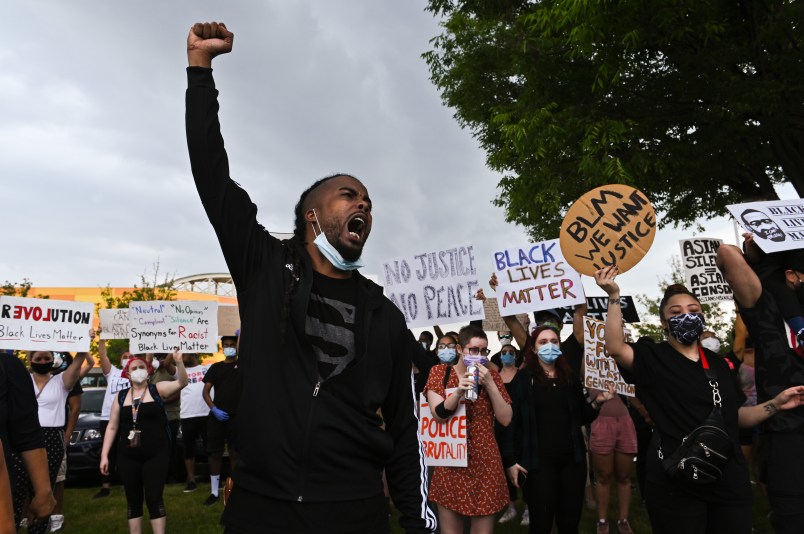The earliest protests over George Floyd’s killing at the hands of the police, starting in Minneapolis and quickly rippling out to big cities across the country, started about a month ago.
The demonstrations featured thousands of people crowded onto streets or gathered in front of government buildings chanting, yelling, singing and, in some cases, coughing after being hit with tear gas. The incubation period for the novel coronavirus can last up to 14 days, per the CDC.
So … why haven’t the cities that saw the largest protests seen comparable upticks in COVID cases?
Spikeless Cities
The story is the same across a slew of cities that played host to an outpouring of fury and disgust after Floyd’s killing and, more generally, the impunity police have enjoyed after killing Black Americans for decades.
In Minneapolis, the cradle of the current movement, there have been testing sites stood up specifically for those who attended the protests.
Four sites run in partnership with the Mayo Clinic reported late last week that only 62 positive cases came out of 4,487 people tested, for a positivity rate of 1.4 percent, said Dave Verhasselt, a spokesperson for the Minnesota Department of Health. And on Tuesday, another Minnesota system called Health Partners reported a .99 percent positivity rate from the 8,500 it protesters tested.
Those figures are actually below the current statewide positivity rate which, per Verhasselt, is currently hovering around 3.6 to 3.7 percent. Hospitalizations have also continued their steady decline in the state.
New York City, which sometimes saw thousands of protesters demonstrating in multiple boroughs at once, is “not seeing an increase in cases associated with the demonstrations (as of yet),” Michael Lanza, NYC Health Department spokesperson, told TPM.
In particular, New York City Health Commissioner Oxiris Barbot said that her department has been closely tracking hospitalizations and emergency room visits, and has seen no spike since the protests began.
The public health department in Seattle is telling the same story.
“We don’t have evidence that the rallies or protests are being associated with large numbers of cases currently,” Colette Cosner, department spokesperson, told TPM. “There is no one source of exposure that is jumping out at us from the data as a driver of cases.”
And in Washington D.C., which has been undulating with daily protests for weeks — memorialized most famously in pictures from the aggressive clearing of Lafayette Square for the President’s photo-op — the positivity rates are getting better, not worse.
“D.C. Health is still analyzing data to assess the impact of first amendment events in D.C., however we are continuing to see a downward trend in cases overall for the District,” D.C. Health spokeswoman Alison Reeves told TPM.
The same seems to be true in cities across the country.
The National Bureau of Economic Research produced a working paper on Monday after analyzing data from 315 cities that had protests.
“We find no evidence that net COVID-19 case growth differentially rose following the onset of Black Lives Matter protests, and even modest evidence of a small longer-run case growth decline,” the researchers concluded.
They even found that net stay-at-home behavior actually increased while the protests roiled urban centers, hypothesizing that the demonstrations compelled non-protesters to more diligently stay home and avoid public spaces.
Why Is This The Case?
“My first reaction is that we’re lucky,” laughed Dr. Susan Hassig, an epidemiologist at Tulane University’s School of Public Health and Tropical Medicine.
She pointed to two features of the protests in her home city of New Orleans that appear to be shared with demonstrations in other cities: they are taking place outside, and the majority of participants are wearing masks.
When it comes to COVID-19, she said, being outside is simply less risky than being inside.
“It doesn’t have to do with UV light, it has to do with dilution,” she told TPM, a subtle poke at President Trump. “What it appears with this virus is that though it’s highly contagious, to get a good infectious process going, you need to start with a substantive amount. Dilution disperses viral particles present in the physical area.”
That level of dispersion just doesn’t happen inside, she said, especially during the summer when air conditioners are recirculating the same air.
Dr. Leana Wen, an emergency physician and former Baltimore Health Commissioner, warned that we may not yet have the full picture from the protests, since there could be a delay in protesters experiencing symptoms and getting medical care. If the data holds, though, she pointed out how this knowledge could play into how people live their lives while the pandemic still lingers.
“This should help to inform people even more about big decisions they can make in their own lives, to be doing as much as they can outdoors vs. indoors,” she told TPM.
The nationwide lack of spikes also speaks to the uniformity with which protesters donned masks at the demonstrations, per Hassig.
“It takes engagement with mask-wearing somewhere above 70 percent, at least 60, to really dampen down transmission,” she said.
Wen added that mask-wearing can reduce the risk of transmission “five-fold.”
The problem with masks, Hassig said, is the psychological element.
She called it a “normative behavior” much like littering. It’s hard to be the first person to drop a wrapper on the ground; it’s much less hard to do so if the pavement is already dotted with trash. That dynamic, she said, can go both ways — people are apt to feel uncomfortable if they’re the odd one out in a group either mostly wearing masks or mostly not.
She singled out political messaging, much of which is coming from the White House, as influencing some of this behavior.
“The sheeple comments, the conspiracy theories about ‘if we get them to wear masks then we can get them to do something else,’” Hassig said. “It’s a serious respiratory virus! It doesn’t care if you’re Republican or libertarian or what.”



